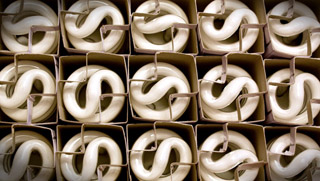Shedding (fluorescent) light on South Africa's power problem
 JOHANNESBURG — The management team at Eskom, South Africa’s partially state-owned power company, had quite a problem on their hands. The second decade of the country’s democracy saw more than 8 1/2 million households gain access to electricity. The rapid expansion in Eskom’s customer base was a less visible repercussion of the end of apartheid. South African power infrastructure was buckling under the demand of a newly free people.
JOHANNESBURG — The management team at Eskom, South Africa’s partially state-owned power company, had quite a problem on their hands. The second decade of the country’s democracy saw more than 8 1/2 million households gain access to electricity. The rapid expansion in Eskom’s customer base was a less visible repercussion of the end of apartheid. South African power infrastructure was buckling under the demand of a newly free people.Starting in 2004, Eskom began to give out compact fluorescent lights, for free, to houses across the country. The effect was twofold. Eskom provided lights for South Africans who, on their own, wouldn’t have been able to afford the more expensive lights. By handing out millions of these bulbs, Eskom has reduced the strain on its power plants, and allowed it to better cope with the country’s growth.
Since the program began in 2004, 52 million fluorescent bulbs have been distributed throughout the country at a cost of $640,000. The strategy has focused on lower income areas in the country, flooding many townships with the new lights.
“It’s certainly our most cost-effective program,” said Eskom General Manger Andrew Etzinger. “We’ve saved the equivalent of a coal-fired power station.”
Eskom itself subcontracts the work of handing out these lights to local, largely black-owned companies, in an attempt to spread the wealth to small, emerging contractors. The aim is to further growth in a business community that still bares the scars of South Africa’s unique history.
Because of the prohibitive cost and South Africa’s relatively mild climate, South Africans tend not to use air conditioning. The biggest spike in energy usage happens during winter here, stretching between May and August. Poorly insulated homes and a lack of central heating leave millions of South Africans dependent on inefficent plug-in heaters to keep warm. In the past Eskom’s overtaxed power plants have struggled to keep the electricity flowing, and has resorted to rolling blackouts.
The fluorescent bulb giveaway is just one of a myriad of programs put together to save energy across South Africa. Eskom has already subsidized 200,000 LEDs for local businesses. As LEDs become more cost effective, Eskom plans to replace the flourecent lights with more efficient, mercury-free bulbs. Eskom has also put money into solar water heaters to alleviate pressure on the grid.
But there is only so much energy that can be saved through more efficient lights and water heaters. Households use only a fifth of the power generated by Eskom, with the lion’s share going toward mining and industry. South Africa boasts the world’s seventh largest deposits of coal, and the mineral provides cheap power for most of the country in some of the world’s largest coal power plants.
You can return to the main Market News page, or press the Back button on your browser.

